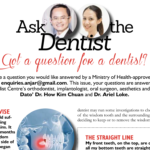|
Oral Surgery is a recognized international specialty in dentistry. It includes the diagnosis, surgical and related treatment of diseases, injuries and defects involving both the functional and esthetic aspects of the hard and soft tissues of the head, mouth, teeth, gums, jaws and neck. It involves, but is not limited to: dental implants, wisdom teeth removal, apicoectomy, TMJ disorder, facial trauma, corrective jaw surgery, oral pathology, osseous tissue surgery, anesthesia and bone grafts.
However, the most common case which requires oral surgery would be the wisdom tooth extraction
(A) Wisdom Teeth Extraction
What are wisdom teeth?
It is the last teeth to develop and erupt into the jaws and is called the third molars. Third molars usually erupt in the late teen years, which coincides with passage into adulthood and is referred to by some as the age of wisdom; hence “wisdom teeth”. Unfortunately, the wisdom teeth are now usually trying to erupt into a jaw that is too small causing problems.
What Problems Can Wisdom Teeth Cause?
Infected gums
When the tooth has only partially broken through the surface, bacteria can enter through the opening or flap around the tooth and cause the gum to become infected.
Decay
Because partially-emerged wisdom teeth are difficult to clean, plaque containing bacteria may form on the surface and create cavities in the wisdom tooth and adjacent teeth.
Crowding and structural damage to other teeth
When teeth become crowded, they lose their proper position in the mouth.
Cyst formation
When a wisdom tooth is impacted, the sac that surrounds the tooth can fill with fluid and form a cyst that is capable of damaging adjacent teeth, the jawbone and nerves. |


